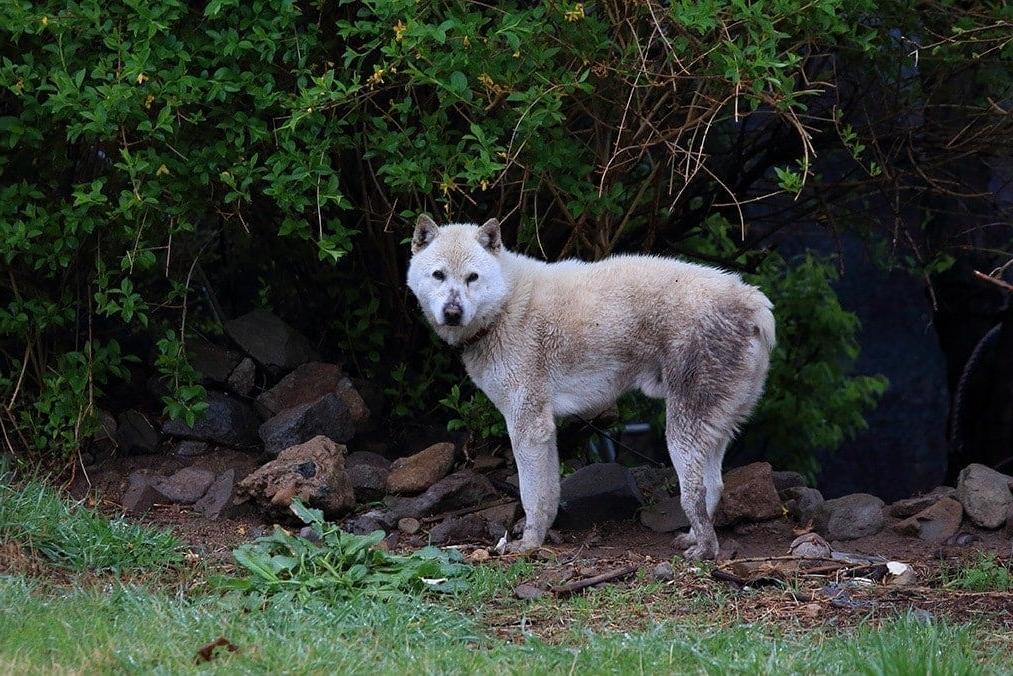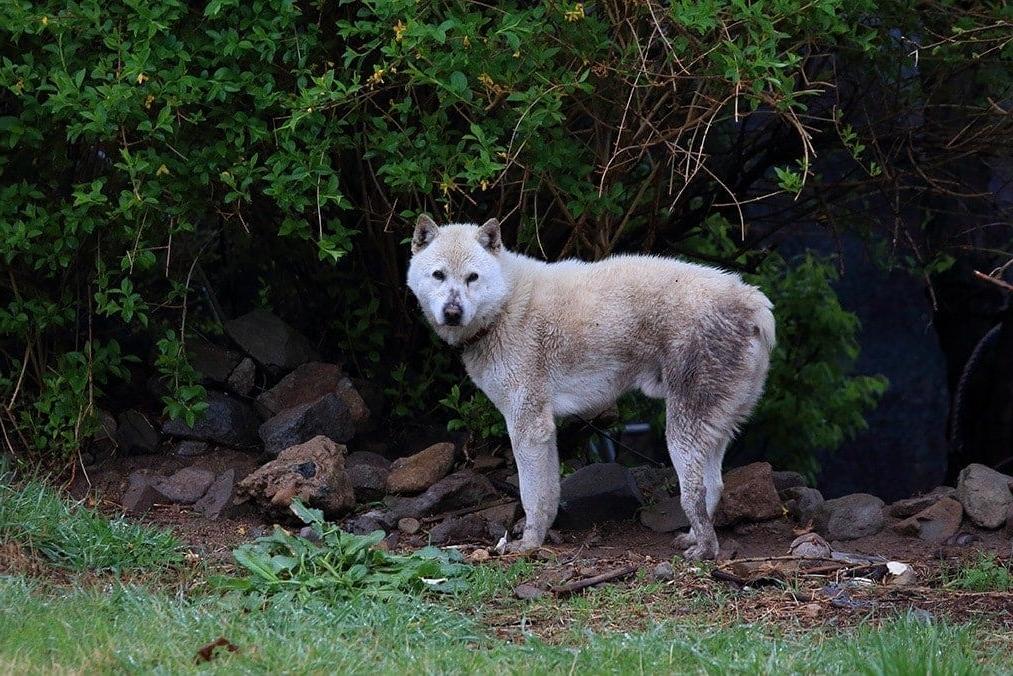- Breed Category: Working Dog
- Country of Origin: South Korea
- Average Height: 35-45 cm; 14-18 inches
- Average Weight: 15-20 kg; 33-44 lbs
- Average Life Span: 12-15 years
- Grooming Requirements: Low, occasional brushing
- Exercise Requirements: Moderate, daily walks
- Coat Type: Short and dense
- Coat Color Variations: Black, white, brindle
- Shedding Level: Moderate
- Ear Type: Erect
- Tail Type: Naturally bobbed
- Temperament: Loyal, alert, intelligent
- Intelligence Level: High
- Barking Tendency: Moderate
- Compatibility with Children: Good with proper socialisation
- Compatibility with Other Pets: Generally good
- Training Ease: Relatively easy
- Common Health Issues: Hip dysplasia, eye problems
- Dietary Needs: Balanced diet, high-quality food
- Energy Level: Moderate to high
- Drooling Tendency: Low
- Sensitivity to Weather: Moderate, prefers mild climates
- Overall Maintenance Level: Low to moderate
- Original Purpose: Hunting and guarding
- Apartment Friendly: Yes, with sufficient exercise
- Best Suited For: Active families, rural settings
- Cost of Ownership: Moderate
- Unique Traits: Naturally bobbed tail
- Cultural Significance: Traditional Korean breed
Imagine a dog that’s as rare as a four-leaf clover, yet as loyal as your best mate. Meet the Donggyeongi, a breed that’s not just unique but also deeply rooted in Korean history. These dogs are known for their bobbed tails, a feature that sets them apart from most other breeds. Originating from Korea, the Donggyeongi has been a cherished companion for centuries, often seen as a symbol of good fortune. This article will dive into the fascinating characteristics, rich history, and essential care tips for this remarkable breed. Whether you’re a seasoned dog owner or just curious, you’ll find the Donggyeongi’s story both intriguing and informative.
History and Origin of the Donggyeongi Breed

Early Development of the Donggyeongi Breed
The Donggyeongi breed traces its roots back to ancient Korea, where it was developed for its unique characteristics and adaptability. These dogs were initially bred in the Gyeongju region, known for their distinctive bobbed tails. This feature wasn’t just a random trait but a result of selective breeding aimed at enhancing their agility and hunting prowess. Over time, the Donggyeongi became a staple in Korean households, valued for their loyalty and protective nature.
Cultural Significance in Korea
In Korean culture, the Donggyeongi holds a special place. Often seen as a symbol of good luck, these dogs were believed to ward off evil spirits. Their presence in homes was thought to bring prosperity and happiness. This cultural significance has helped preserve the breed through the centuries, even as other native breeds faced decline.
Key Historical Figures and Events
Throughout history, several key figures have played a role in the preservation and promotion of the Donggyeongi. Notably, during the Joseon Dynasty, these dogs were favoured by the royal family, which helped elevate their status. In more recent times, efforts by Korean dog enthusiasts and historians have been crucial in reviving interest in the breed, ensuring its survival for future generations.
Physical Characteristics of the Donggyeongi
Appearance
The Donggyeongi is a medium-sized dog, typically weighing between 15 to 25 kilograms. Its coat is short and dense, often coming in shades of fawn, black, or brindle. One of the most striking features is its bobbed tail, a natural trait that gives the breed a distinctive silhouette. This tail, combined with their sturdy build, makes them easily recognisable.
Unique Physical Traits
Beyond the bobbed tail, the Donggyeongi boasts a robust and muscular frame, built for agility and endurance. Their ears are usually erect, giving them an alert and attentive expression. This breed’s compact and powerful physique is perfectly suited for their historical roles in hunting and guarding, showcasing their versatility and strength.
Temperament and Behaviour of the Donggyeongi
Typical Personality Traits
The Donggyeongi is known for its loyalty and intelligence, making it a standout among dog breeds. These dogs are quick learners, often picking up commands and tricks with ease. Their energy levels are moderate, which means they enjoy a good play session but are equally content to relax with their family.
Suitability as a Family Pet and Companion
As a family pet, the Donggyeongi shines. Their loyal nature means they form strong bonds with their human companions, making them excellent family members. They thrive in environments where they are included in daily activities and are given plenty of attention.
Interaction with Children and Other Animals
Donggyeongis are generally good with children, displaying patience and gentleness. They can be protective, which is a bonus for families. When it comes to other animals, early socialisation is key. With proper introductions, they can coexist peacefully with other pets, although their hunting instincts might occasionally come into play.
Training and Exercise Needs of the Donggyeongi

Importance of Early Training and Socialisation
Getting a head start on training and socialisation is crucial for the Donggyeongi. These dogs are naturally intelligent and eager to learn, but early exposure to different environments, people, and other animals helps them grow into well-rounded companions. It’s all about setting the stage for a confident and adaptable adult dog.
Recommended Training Techniques
Positive reinforcement is the way to go with the Donggyeongi. They respond well to treats, praise, and play as rewards. Consistency is key, so short, regular training sessions work best. Keep it fun and engaging to hold their interest and reinforce good behaviour.
Daily Exercise Requirements and Activities They Enjoy
The Donggyeongi has moderate energy levels, so daily exercise is a must. A mix of walks, playtime, and mental stimulation keeps them happy and healthy. They love activities like fetch, agility courses, or even a good romp in the backyard. Keeping them active not only satisfies their physical needs but also strengthens the bond with their human companions.
Health and Lifespan of the Donggyeongi
Common Health Issues
Like any breed, the Donggyeongi has its share of health concerns. They can be prone to hip dysplasia and certain skin conditions, which are common in medium-sized dogs. Regular vet check-ups are essential to catch any issues early and keep them in top shape.
Average Lifespan and Health Tips
The Donggyeongi typically enjoys a lifespan of 12 to 15 years. To help them live a long, healthy life, a balanced diet and regular exercise are crucial. Keeping their weight in check can prevent joint problems, while mental stimulation keeps their minds sharp.
Preventative Care Recommendations
- Schedule regular vet visits for vaccinations and health screenings.
- Maintain a consistent grooming routine to monitor skin health.
- Provide a nutritious diet tailored to their age and activity level.
- Engage them in daily physical and mental activities to prevent boredom.
By following these simple steps, you can ensure your Donggyeongi remains a happy and healthy companion for years to come.
Grooming and Maintenance of the Donggyeongi

Coat Care and Grooming Routines
The Donggyeongi’s short, dense coat is relatively low-maintenance, but regular grooming is still important. A weekly brush will help keep their coat looking its best and remove any loose hairs. This routine not only keeps them tidy but also strengthens your bond with them.
Shedding and Seasonal Grooming Tips
While the Donggyeongi doesn’t shed excessively, you’ll notice an uptick during seasonal changes. During these times, brushing a few times a week can help manage the shedding and keep your home fur-free. A good quality brush designed for short-haired breeds will make the task easier and more effective.
Bathing is only necessary when they get particularly dirty or start to smell. Over-bathing can strip their coat of natural oils, so it’s best to keep it minimal. Regular checks of their ears, teeth, and nails are also part of a good grooming routine, ensuring they stay healthy and comfortable.
Diet and Nutrition for the Donggyeongi

Nutritional Needs for Optimal Health
Feeding your Donggyeongi the right diet is crucial for their health and vitality. These dogs thrive on a balanced diet rich in proteins, healthy fats, and essential vitamins. High-quality commercial dog food, specifically formulated for medium-sized breeds, often meets these needs. However, adding fresh ingredients like lean meats, vegetables, and grains can enhance their diet.
Foods to Include and Avoid
Include foods like chicken, fish, and sweet potatoes, which are great for their coat and energy levels. Avoid foods high in fat and sugar, as well as those that are toxic to dogs, like chocolate, onions, and grapes. Always ensure their food is free from artificial additives and preservatives.
Feeding Schedules and Portion Recommendations
Establishing a consistent feeding schedule helps maintain their digestive health. Typically, two meals a day—morning and evening—work well for adult Donggyeongis. Puppies may require more frequent meals. Portion sizes depend on their age, weight, and activity level, so it’s wise to consult with your vet for tailored advice.
Fun Facts and Trivia about the Donggyeongi

Interesting Tidbits about the Donggyeongi Breed
The Donggyeongi is not just any dog; it’s a piece of living history. Did you know that this breed is one of the few with a naturally bobbed tail? This unique feature has been a part of their charm for centuries. It’s not just about looks, though. The bobbed tail was historically believed to enhance their agility, making them excellent hunters.
Another fascinating fact is their rarity. The Donggyeongi is considered a national treasure in Korea, and efforts are ongoing to preserve this unique breed. Their numbers dwindled in the past, but thanks to dedicated enthusiasts, they’re making a comeback.
Cultural References and Significance in Korean History
In Korean folklore, the Donggyeongi is often associated with good fortune and protection. Families believed that having one of these dogs in the home would ward off evil spirits and bring prosperity. This cultural significance has been a key factor in their preservation over the years.
Historically, they were favoured by Korean royalty, which only added to their allure. Today, they continue to be a symbol of Korean heritage, celebrated in festivals and cultural events across the country.
Final Thoughts

The Donggyeongi is a unique symbol of Korean heritage. This breed’s loyalty and intelligence make it a cherished companion. Balancing its historical significance with modern care needs, the Donggyeongi offers both challenges and rewards for dedicated owners. Embracing this breed means preserving a piece of history while enjoying a loyal friend. Consider welcoming a Donggyeongi into your life and contribute to its legacy.
